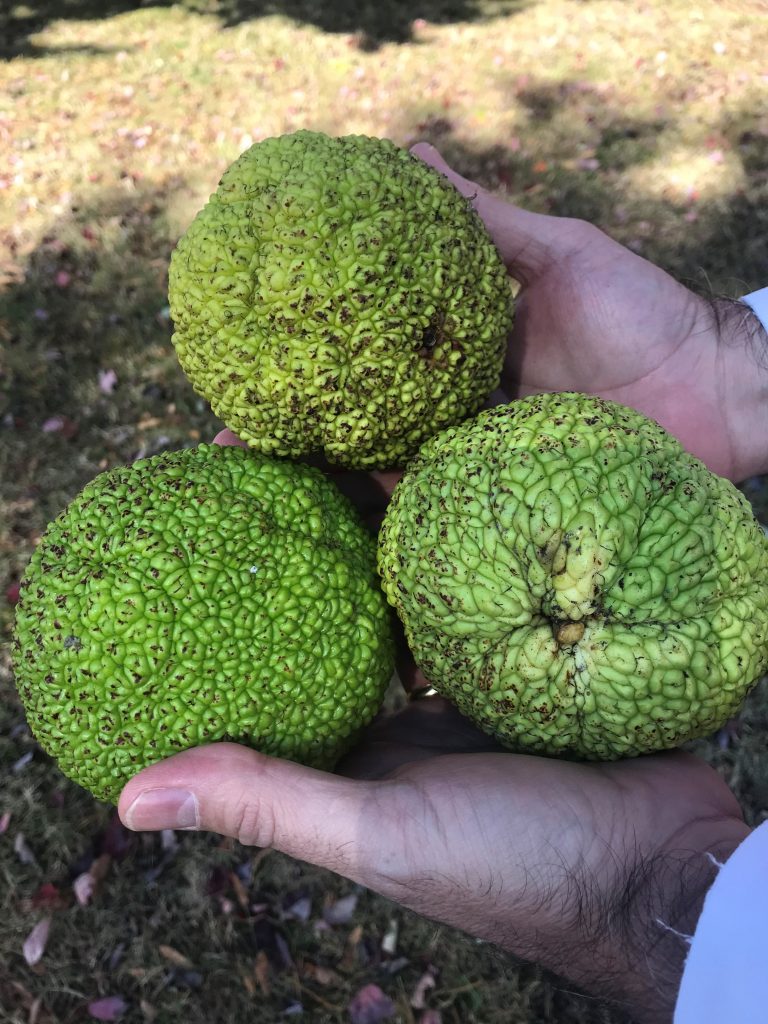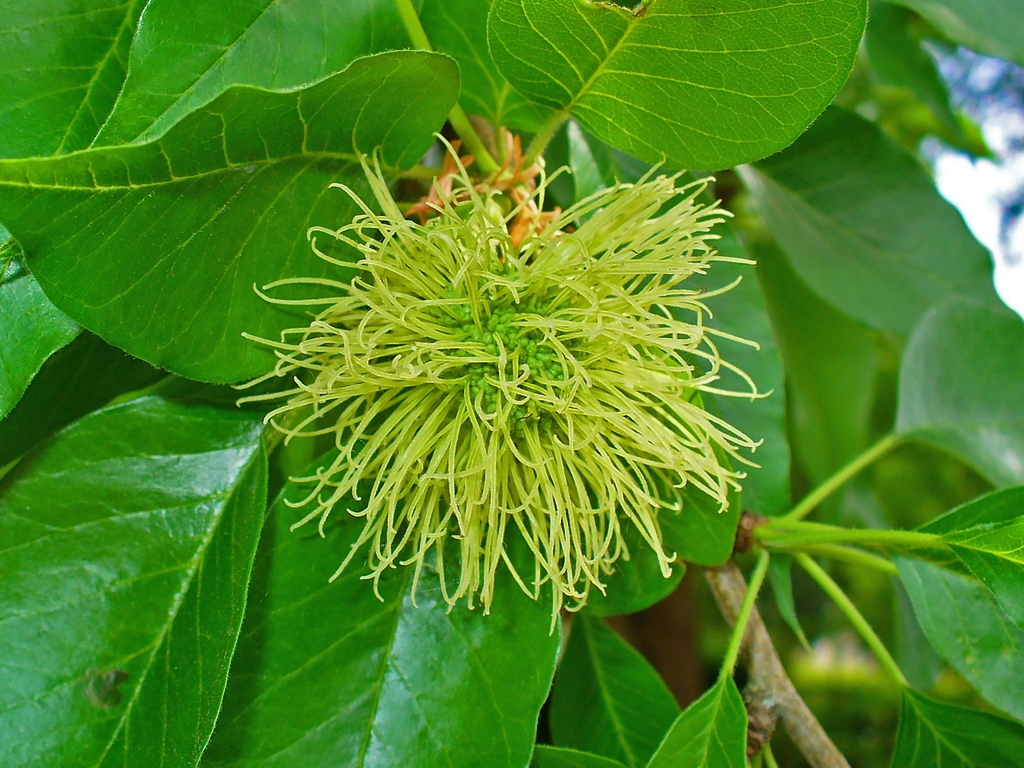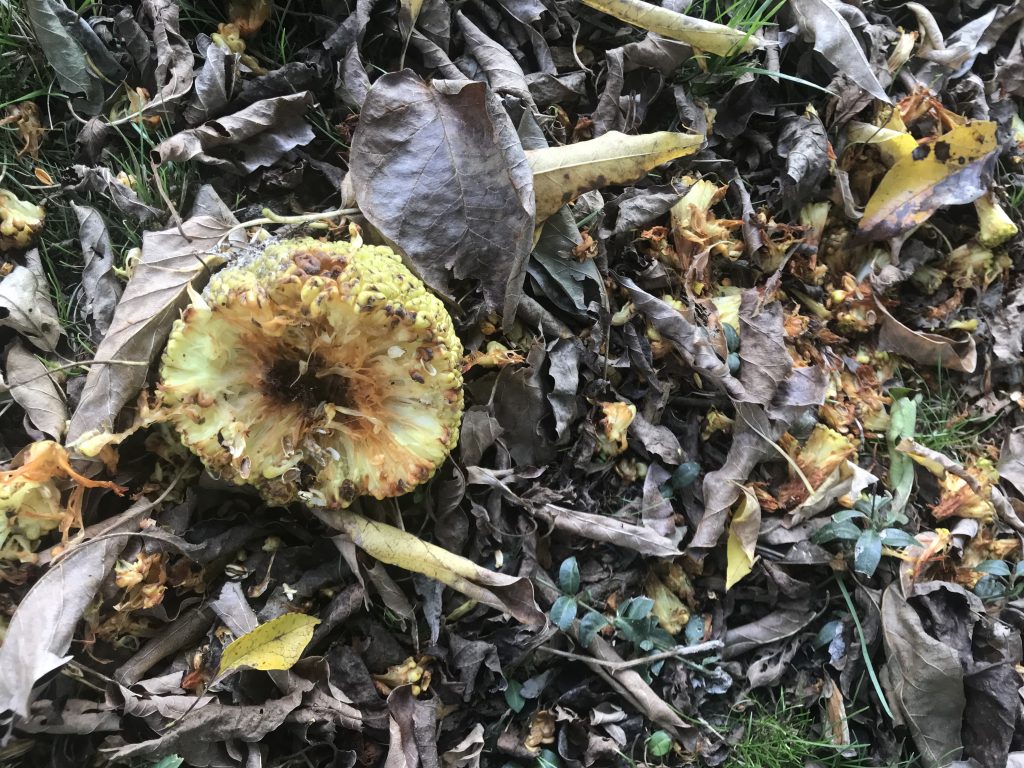The Osage Orange, Maclura pomifera, is a native to a narrow belt in eastern Texas, southeastern Oklahoma, southwestern Arkansas, and the extreme northwest corner of Louisiana. But it has been introduced and has become naturalized throughout much of the eastern United States, including Virginia.

Description: Osage orange belongs to the Moraceae, or mulberry family. Maclura is named in honor of William Maclure (1763 – 1840), an early American geologist; pomifera means “fruit-bearing”. It is a small to medium sized tree reaching heights to 70 feet tall, with deeply furrowed bark and thorny branches. Leaves are deciduous, simple and smooth, dark green and waxy above; paler green with a few hairs beneath. Fall color is a translucent yellow. Osage orange are dioecious and wind pollinated with flowers appearing in mid-May to June after leaves. The fruit or “Hedge ball” is produced in September and is a multiple fruit consisting of many 1-seeded druplets fused into a globose, yellow-green structure. The Osage orange is a good pioneering species because it can tolerate many different soil types.

Historically wood from the tree was used by Native American tribes to produce wooden bows. The French found the Osage Indians making bows from the wood and called the tree Bois d’Arc (meaning wood of the bow). Because the tee was used by the Osage Indians and the fruit’s resemblance to oranges, that the tree received another common name: Osage Orange. Other common names include hedge apple, horse-apple.
Early pioneers used the wood for making hubs and wheel rims for horse drawn wagons, mine support timbers, posts and many other uses where decay resistance was important.
In the 1850’s John A. Wright, editor of the Prairie Farmer and his friend professor Jonathan B. Turner proposed using the tree for hedges. The tree has many characteristics that make it a good natural hedge including: scattered thorns set on zigzagging branches; tolerant of drought, heat, and wind; it can easily be propagated; and it grows rapidly. Osage orange can also be pruned to form a low, tight hedge.

Because of those characteristics, Professor Turner was convinced that Osage orange was the perfect plant to fence the prairie. By 1855 Osage orange made fencing entire prairie farms practical, and the practice had spread rapidly throughout the prairie states to most of the eastern states. Then the invention of woven and barb wire caused the hedge row to be used less from 1875 forward.
In Henrico County, Walkerton Tavern is located in the West End on Woodman Road. Walkerton was built in 1825 for John Walker and the Tavern served travelers along Mountain Road. It is at Walkerton Tavern that you can see a hedgerow of 21 mature Osage Orange trees.

The large fruit, 3 to 5 inches in diameter, can be a hazard as they fall from the tree. The fruits can also be a hazard on the ground when stepped on or mown over. Squirrels and other small rodents will enjoy eating the fallen fruit. Decorators and floral designers often use as decorations or centerpieces in the fall.

Photo of eaten fruit, of Osage Orange trees at Walkerton Tavern, Henrico, Virginia on November 11, 2021. Photo by: E.R. Olsen, Virginia Cooperative Extension, CC BY-SA 3.0
References:
Smith, S.L. and J.V. Perino. 1981. Osage orange (Maclura pomifera): history and economic uses. Economic Botany. 35:24-41.
Wynia, R., 2011. Plant Guide for Osage orange (Maclura pomifera). USDA-Natural Resources Conservation Service, Manhattan Plant Materials Center. Manhattan, KS 66502.
Wynia, R. 2011. Plant fact sheet for Osage orange (Maclura pomifera). USDA-Natural Resources Conservation Service, Manhattan Plant Materials Center. Manhattan, KS 66502
